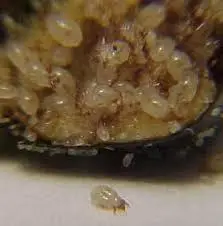Bulb Mite
Overview
The Bulb Mite attacks bulbs and roots of many plant species, including freesia, gladiolus, hyacinth, lily, iris, narcissus, dahlias and tulips.
Bulb Mite has an oval body shape approximately 0.6-0.9 mm long. It is translucent with a shiny appearance and has short, reddish-brown legs.
The eggs are shiny, clear and oval-shaped. They are about 1/2 the size of the adult mite.
Why you need to control Bulb Mite
Bulb Mites will typically attack your crop through the basal plate of the bulb or the outer skin layers. Mites develop more quickly if a bulb is bruised or damaged.
When a bulb is infected with Fusarium rots, mites establish and develop in less than half the time compared to healthy bulbs.
On freesia and gladiolus, damage appears as dark brown streaks on the roots, which may also be internally "mined."
Corms or bulbs grown in soils infested with Bulb Mite will have distorted leaves and growing points. High numbers of Bulb Mites can quickly transform an entire bulb into rotten pulp.
Beneficial predators to control Bulb Mite among crops
Biological Services has products to help you control Bulb Mite in your commercial crop and can design an effective program incorporating Hypoaspis A (Hypoaspis aculeifer).
Get tailored advice for your commercial crop
To speak with one of our qualified consultants about your current commercial crop challenge or to learn about the benefits of the IPM maintenance and monitoring services we provide, contact us.


